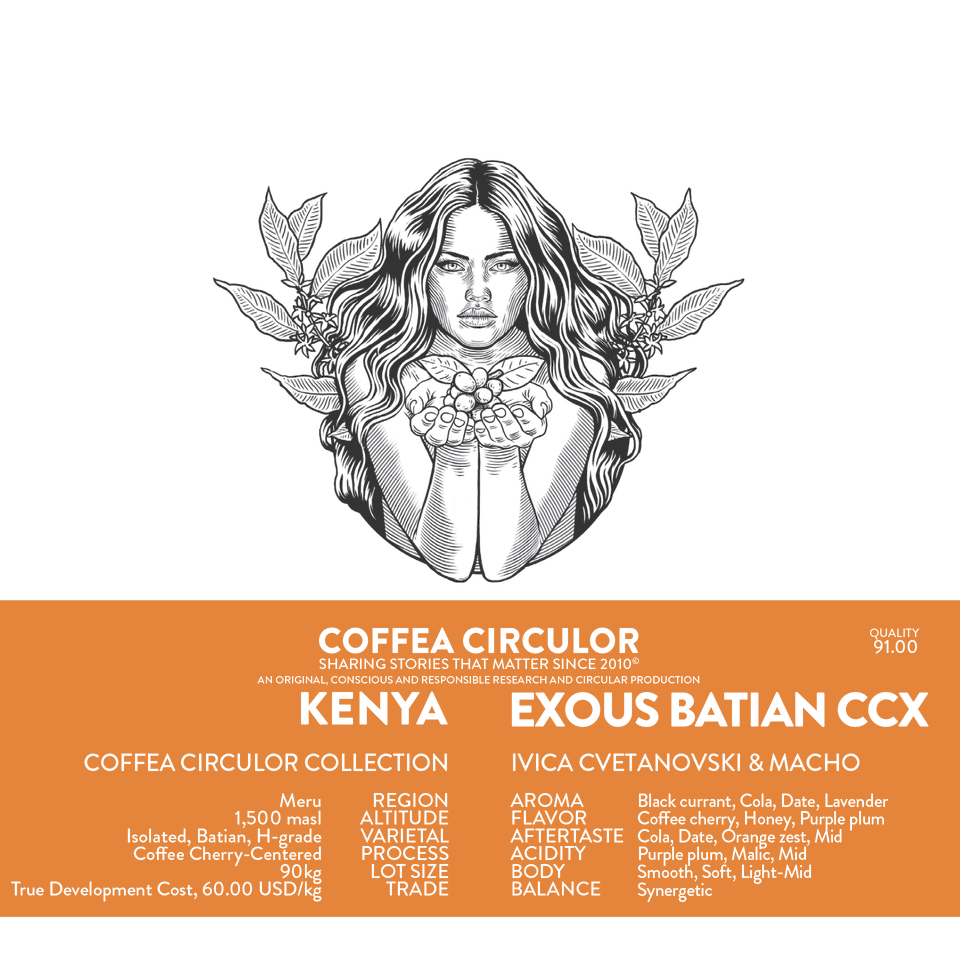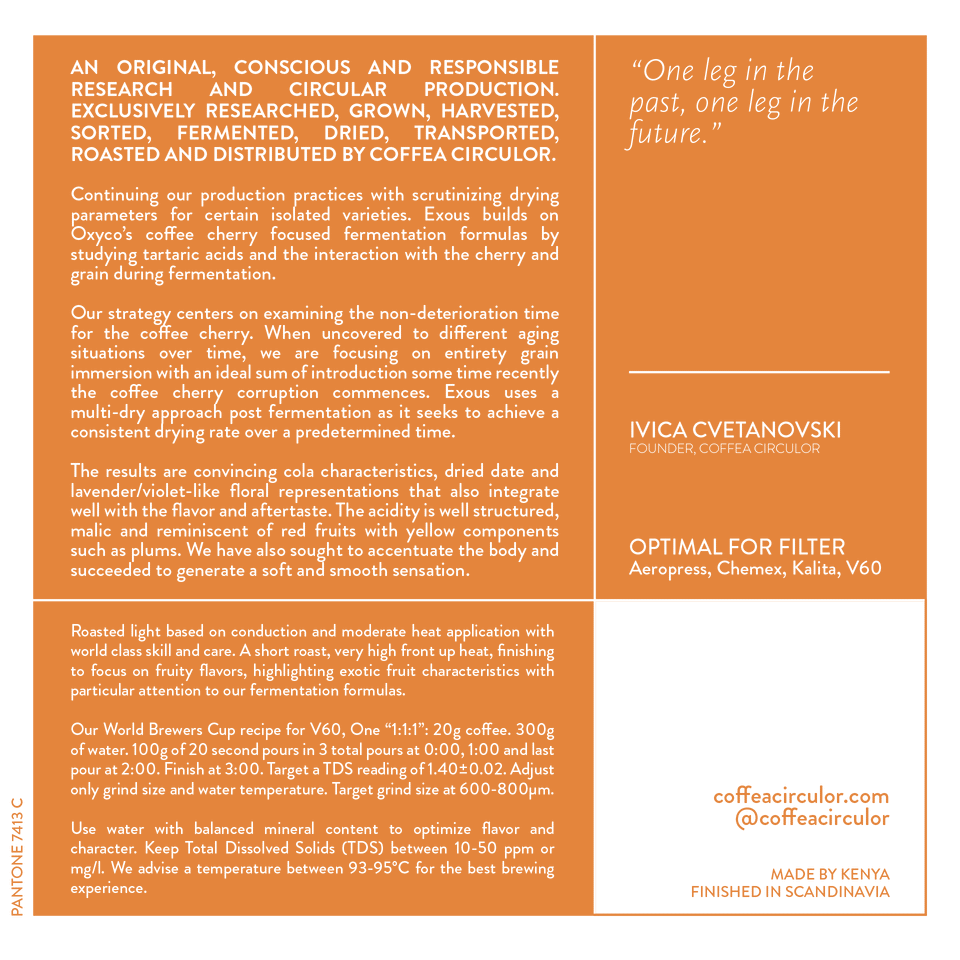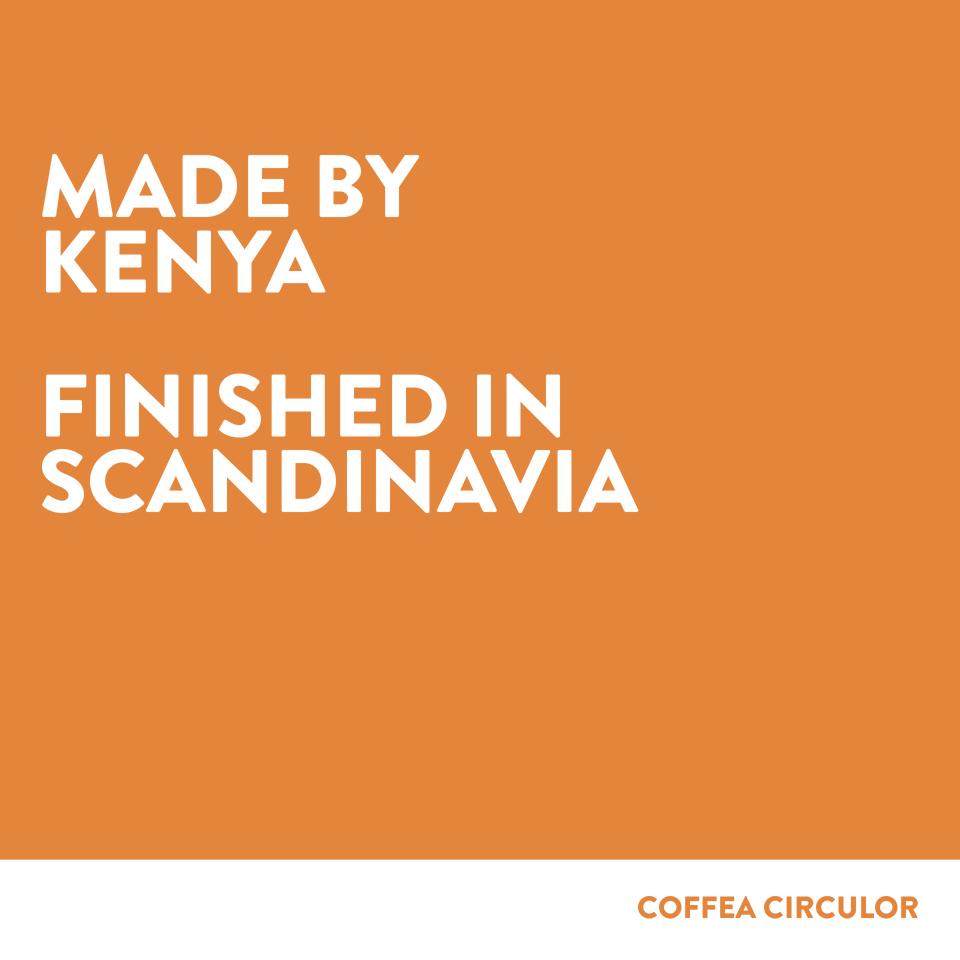KENYA Coffea Circulor Exous Isolated Batian CCX
Finished and shipped from Sweden with standard or express shipment worldwide. Learn more about production cut-offs and shipping here
An original, conscious and responsible research and circular production. Exclusively researched, grown, harvested, sorted, fermented, dried, transported, roasted and distributed by Coffea Circulor. Sustained by internal funding by utilizing our True Development Cost-initiative rendering a unique, fully accountable and complete production cycle. Transparency in all sub-production phases - as we originally envisioned it in early 2000s - an authentic reality.
“One leg in the past, one leg in the future.”
Ivica Cvetanovski
Founder, Coffea Circulor
SCA SCORE 91.00
FLAVOR ALGORITHM AND DESIGN Ivica Cvetanovski
Roasted light based on conduction and moderate heat application with world class skill and care. A short roast, very high front up heat, finishing to focus on fruity flavors, highlighting exotic fruit characteristics with particular attention to our fermentation formulas.
NAMING
Exous, short for exogenous, is the combination of Exo (referring to the coffee cherry) and Us (referring to our interpretation of drying mechanisms).
PRACTICAL VISION AND RENDITION OF ROASTING DESIGN AT COFFEA CIRCULOR
There is one word in the Macedonian language (my origin is Macedonia, born and raised in Sweden), and that word is “sok”.
That word has no other reference or synonym in (at least) the English language what I know. It can be explained as:
“Remember when your Mom made juice from picked berries and fruits in the garden?”
That is “sok”, possibly something similar can be “natural, refreshing fruit juice” in the English language. This is what I am making with the coffees and wish that people experience it like so:
"The ideology in my roasting is to highlight natural flowers, fruits and berries while preserving important sweetness and integrating playful acidity creating long lasting memories."
COFFEA CIRCULOR KENYA ESTATES
Learn more about Coffea Circulor Kenya Estates here.
GENESIS
| Producer | Coffea Circulor (Ivica Cvetanovski & Macho) |
| Country | Kenya |
| Region | Meru |
| Altitude | 1,500 masl |
| Varietal | Isolated, Batian, H-grade |
| Process | Coffee Cherry-Centered |
| Lot size | 90kg |
| Trade | 14.00 USD/kg (CEP)*. 60 USD/kg (TDC)** |
* CEP - "Customer Expectancy Price".
Here illustrating a typical/"standard Kenyan trade offering" (green coffee) which usually translates to a 16 EUR retail (roasted) on the market in 2021.
** TDC - "True Development Cost".
Here illustrating accumulated costs for administration, communication, research, development, fermentation, drying, milling, logistics, internal/import/export/shipping/certificates. No final production (roasting, analysis, distribution) is accounted for.
SENSORY EXPERIENCE
| Aroma | Black currant, Cola, Lavender |
| Flavor | Coffee cherry, Honey, Purple plum |
| Aftertaste | Cola, Dates, Orange zest |
| Acidity | Purple plum, Malic, Mid |
| Body | Smooth, Soft |
| Balance | Synergetic |
SYNOPSIS
Continuing our production practices with scrutinizing drying parameters for certain isolated varieties. Exous builds on Oxyco’s coffee cherry focused fermentation formulas by studying tartaric acids and the interaction with the cherry and grain during fermentation.
Our strategy centers on examining the non-deterioration time for the coffee cherry. When uncovered to different aging situations over time, we are focusing on entirety grain immersion with an ideal sum of introduction some time recently the coffee cherry corruption commences. Exous uses a multi-dry approach post fermentation as it seeks to achieve a consistent drying rate over a predetermined time.
The results are convincing and each characteristic is transparent, clear and conclusive.
Workflow
What could possibly introduce ambiguity is when we refer to the coffee cherry, we also account for that (likely) many coffee consumers are not familiar with how the actual coffee cherry fruit tastes in various stages of its lifespan unripe and ripe cherries, picked cherries, fermented cherries and dried cherries.
Through this statement and observation, we wish to illuminate our goal with our research and development of our proprietary fermented Kenyan collection based on our Hypoxia and CCX formulas: To bring the coffee consumer as close as physically possible to not only the classical stated “terroir”, but showing the aphorism “coffee is a fruit” to be true by proof of concept.
Our aim is to push the sensory experience as close to the coffee cherry as possible. This proves to be a difficult task since (probably) many have not tasted a “raw” coffee cherry directly after being picked from a coffee tree. From here, we are also asking us what are the boundaries for a coffee and its selected fermentation formula. Through our research, we have identified specific parameters which can be summarized as some varieties being less or more suitable for exposure for specific types of fermentation. Therefore, one can as what is a "valid or accepted range" before either a coffee is seemingly perceived as being fit for purpose - or better yet: Is fermentation performed just "because" or is there actually any science and theories that work well in practice. Different fermentation formulas applied to specific varieties amplify specific differences between seeds from the same batch / lot.
Optimally understanding how specific parts of the coffee cherry is exposed to various fermentations, for example why particular beans which are picked on the very same minute to hour, fermented in the same batch / lot, display different characteristics such as perforation of mucilage. This, even having the same "in"-data, the "out"-data is different where obvious parameters such as speed of fermentation, different and unwanted environments which lead to non-uniform results. Non-consistency is an undesirable factor which we are striving for to stabilize and seek to completely remove. This also becomes more prominent when the coffee is considered "ready" and also to move the the roasting phase. We strive for predictability and consistency. For future purposes, replicability is very important.
Prior to the fermentation era, some might argue that the coffee industry was rather 2-dimensional: consumers were able to taste various "stages" of coffee roasting, ranging from Maillard to pyrolysis and extended pyrolysis. In recent years, now being 2022, fermentations have become more prominent and also through various technical equipment, data collection and statistics can elevate aromatics and flavors. Using this analogy with roasting that actually takes place later in the coffee production value chain, with Ortho we also investigate how "far" certain aspects in fermentation can be carried out with the Batian variety by eliminating certain unwanted side-effects.
In summary, we have:
- completely eliminated any use of water in all stages of the production phase,
- continued to study our coffee cherry / cascara,
- distilled the dried coffee cherry resulting in an alcoholic beverage to understand the flavors of the coffee cherry,
- better understood how far fermentations are in progress before actual drying commences based on the fact that fermentation is still ongoing until a certain moisture level is reached,
- studying moisture content based on how specific beans are affected by fermentations and why certain beans are more affected than others belonging to the same lot / batch,
- applying various drying techniques such as accelerated versus prolonged drying rates at various stages,
- focusing on stability and consistency.
General observations and recommendations for Exous
Kindly note that extracting the coffee with higher mineral concentration will bring forward more strong, darker colored berries such as blackberries, ripe cherries, overripe strawberries, etc.
Coffea Circulor Kenya operations
Coffee is boundless, timeless and touches people deeply all across different cultures and generations. We want to take you on a journey where you rediscover Kenya and a new approach to coffee production where the main product is not the coffee as a grain.
Oido is the first Kenya coffee to be released in the new year of 2023. Meanwhile, the Kenya projects and production continues to be based on projects and results in the past and present such as:
- Study of botanical varieties in Kenya with focus on rooting systems, physical support, water and heat retention, nutrients, oxygen and soil interaction.
- Panama Finca Deborah Geisha Natural (pre-Afterglow) competition lot 2016 focusing on controlled drying environments, coffee cherry (cascara) and grain aging.
- Uganda Kwoti (a.k.a “Mzungu Project”) from 2016 with support from the Norwegian Government focusing on elevation-based harvesting and kickstarting fermentations.
- Isolated cherry picking, reduced water based fermentation formulas and drying projects in Kenya.
- Drying and macerated fermentation projects at Altieri farms in Panama.
Introduction
Our intention with Oido is to go beyond aromatics and flavors, namely to evolve and elevate specific details that are barely spoken about considering coffee production: impact and heritage. A direct example would be climate change mitigation, creating vintages for coffees, studying aging of the grain post-production particular to various fermentations.
Background
In 2005, Coffea Circulor founder Ivica Cvetanovski observed the combination of coffee varieties at Kenyan coffee processing stations. This unification of coffee varieties that make up “mixed lots” at washing stations in Kenya removes the notion of “single estate” and “single variety”. Varieties such as SL28, SL34, Ruiru 11, K7, etc. were “blended” without any particular notion taken to ratio. This is mainly due to small scale farmers / smallholder pick their cherries as a cash crop, delivery to the closest drop off point. Coffee cherries are often personally carried to a local coffee processing station. At the station, cherries are weighted and the producer receive a voucher based on the weight. The voucher can later be redeemed for cash, Mpasa (electronic cash) or other monetary funds. This method of a post-cherry delivery payment is well established in Kenya and also incentivizes the small scale producer to unfortunately not always pay attention the cherries to carry a certain quality. Coffee cherries rather convey a more important heft because it simply is the weight that pays at the nearest processing station. Additionally, no particular notion is put on which varieties are picked and delivered: “the end product is coffee regardless”.
Current and ongoing status in Kenya
The notion of “single variety coffee” in Kenya has transformed to “Kenyan Heirloom”. Like its neighboring country Ethiopia, the term “heirloom” is a “collective” name for both identified and non-identified varieties. It is also a common practice to “mix” lots in Ethiopia, yet the “mix” occurs earlier in the chain of events - namely unconscious picking by the producers based on what coffee trees are present on their land. At times, some knowledge of specific plants on the producer own land is passed on by ancestors or in-depth botanic knowledge.
The Kenyan sorting mechanism of coffee as a grain is well established with its AA, AB, PB, etc. grades. However, there is no particular variety isolated approach or focus before reaching the sorting station and size-sorting. In addition, processing station workers are (mostly) instructed to quickly inspect cherries via visual cues, namely sort out possible greens and slight anomalies. Even if particular small scale producers harvest and bring a specific variety to stations, it is often “mixed” and not processed separately. This is also due to processing small scale or single lots are too small to be cared for. Another straight forward reason is that much more attention is needed for that particular lot to be processed separately. Attention means time and time is money. Namely, it has to be sorted, de-pulped, fermented in a dedicated water tank, dried in parchment on dedicated raised beds and milled separately. Each stage requires meticulous attention and responsibility, traceability and dedicated staff, individually. With the incentive to produce quantity before quality, this is where we are in 2021 and this is what has taken the center stage in our research and implementation.
Whilst there are some recordings of people in general noticing the sensory experience from Kenya “is not tasting as before”, the notion of “black currant” is absent, something that has carried the Kenyan signum, it is mainly as described the result and effect of underpaid coffee producers. With no incentive provided to produce high-quality coffee and focusing on quantity based on only picking cherries, cooperatively owned processing stations collect available coffee cherries and “mix them in one pot”. With no reference to ratios of the varieties being a key reason, there can be many more that go beyond our knowledge. Regardless, it is alarming and must be addressed from mainly two perspectives: quality coffee production requires attention and understanding from everybody - even end-consumers (both retail and wholesalers). Part of this is our developed Customer Expectancy Price (CEP) and True Development Cost (TDC).
Results
We are adding our findings to previous years production results. Key findings include:
- Continuing our implementation of the multiple variety isolation (MVI) strategy where several Kenyan varieties are explicitly picked and fermented separately with focus on SL28, Batian and Ruiry 11 in the production year of 2023.
- Fine-tuning internal infrastructure (test, analysis and drying facility) with optimized placement of various drying tools.
- Improved handling of defects pre- and post-harvest for each isolated variety by cross-referencing previous years and its effect on the final result. Sorting of potential chipped beans has improved.
- Staying faithful to our True Development Cost and seeking methods to improve production and quality through cost efficiency.
Continuing from the 2021 year production, by fully implementing our True Development Cost (TDC) versus Customer Expectancy Price (CEP) for the entire collection of proprietary developed coffees, this range of coffee is not able to be offered at an “expected price” that could be considered being “standard pricing” set by market actors for an origin.
Conclusions and future work
With Coffea Circulor proprietary produced coffees, people can experience them with the equal emotional power as when it was created and bend the human condition towards good. Our goal is to convey this experience which also contributes to the development of regions and cultures.
We at Coffea Circulor have decided to be understood as a brand that conveys emotional experiences in coffee products based on science, innovation, originality, socio-financial approaches, health, improvement of livelihoods, development, payment for ecosystem services and environmental care.
Additional work remains in various categories such as:
- Expanding production areas,
- Implementing more optimal sorting procedures,
- More help with administration and finances is needed,
- Reducing the TDC with the aim to bridge the gap to the CEP,
- Better understand how specific coffee cherry values affect the “quality” of the grain, not roasted and roasted,
- Climate/weather matters, except specific issues already recorded, will need more attention due to spontaneous fluctuations in the local weather affecting production facilities, and
- Additional analysis and conclusions to be drawn from the 2021 production.
FERMENTATION MORPHEMES
As each picked coffee cherry is destined for specific fermentation formulas, we denote each lot carrying the same name with a morpheme. Below is a listing of most common fermentation practices. Please use this reference to better understand the differences between equally named coffees and their fermentation formulas. For example, read a suffix of "NASDX" such as Natural Anaerobic Slow Drying Fermentation".
| AX |
Anaerobic Fermentation |
| CX |
Cold Fermentation |
| CMX |
Carbonic Maceration |
| DX |
Dry Fermentation |
| EX |
Extended Fermentation |
| FMX |
Fruit Maceration |
| RH, WH, BH | Honey Fermentation |
| HX | Hypoxia Fermentation |
| MX |
Macerated Fermentation |
| NX | Natural Fermentation |
| SX |
Slow Fermentation |
| WX | Washed Fermentation |
| YX |
Yeast Fermentation |
EXTRACTION RECOMMENDATIONS
Our World Brewers Cup recipe, One (1:1:1), for Hario V60-01/02 with Hario VCF-01/02 filters:
- Rinse the VCF-filter with 93°C water. Rinse the carafe/server with hot water to expel any unwanted aromatics and flavors from the rinsed filter.
- Coffee: 20g.
- Water: 300g @ 93-95°C, TDS: 10-50 mg/l.
- 100g of 20 second pours in 3 total pours at 0:00, 1:00 and last pour at 2:00. Finish at 3:00.
- Pour by pulsing in helix formation during 20 seconds, starting from the centre, 5 revolutions per pulse. Ensure no grinds persist on the filter wall in the last pouring pulse.
- At 01:00, 02:00 and 03:00, confirm the filter bed is flat and uniform. Avoid generating cavities and craters.
- Target a TDS reading of 1.40±0.02.
- Adjust only grind size and water temperature.
- Grinding: Target 600-800μm. Example: 28 turns from the finest setting on Comandante.
- If the flow ends past each minute, adjust your grind settings to finer and respectively for slower flow.
- The recipe, technique and formula is singularly linear and time efficient. Learn more about linearly up- and downscaling our recipe here.
Find more recommendations for other devices here.
WATER RECOMMENDATIONS
Use water with balanced mineral content to optimize flavor and character. Keep Total Dissolved Solids (TDS) between 10-50 ppm or mg/l. We advise a temperature between 93-95°C for the best brewing experience. Target the following values.
| Calcium (Ca) | 0.9 mg/l |
| Sodium (Na) | 1.7 mg/l |
| Silicon Dioxide (SiO2) | 1.4 mg/l |
| Potassium (K) | 0.3 mg/l |
| Magnesium (Mg) | 0.2 mg/l |
| Sulfate (SO4-) | <7.0 mg/l |
| Chloride (Cl-) | 2.5 mg/l |
| Nitrate (NO3-) | 0.1 mg/l |
| Fluoride (F-) | <0.1 mg/l |
| pH | 6.2 |
STORAGE RECOMMENDATIONS
Please store in a cool and dry place in order to secure freshness and quality. To ensure best possible experience use within 3 months after roast date and 2 weeks after opening. In various environments and setups, your brewing experience can benefit from opening the bag and closing it. Wait one day to brew. We have invested significant time to research the durability of the coffee by actively refining our roasting algorithms to ensure perpetual quality post 3 months of production. Our flavor-lock packaging technology is based on processing and roasting. This ensures persisting and stable aromas, flavors and pro-experience.
TEMPORALITY RECOMMENDATIONS
Start using at will. Brew immediately or wait several weeks. Prepare for a championship with a strategy. It all depends on your goals.
We recommend using the coffees by first opening the container/bag one day before the first planned brew to enable a natural aeration of the coffees. Use according to the following matrix and remember these are general observations given parameters such as continent, country, region, variety, altitude, process, etc. combined with Coffea Circulor processing and roasting algorithms.
Plan your acquisition according to production schedules (roasting), event attendance (home/championship) and shipping priority (standard/courier).
| 0-3 days | Focused acidity |
| 4-7 days | Optimal Coffea Circulor recommended praxis |
| 8-14 days | Increased floral perception |
| 15-21 days | Increased sweetness |
| 22+ days | Increased balance |
| 1+ month | Intact sweetness, peak intensity |
| 2+ months | Inherent balance, possible reduced florals turning herbal |
Made by Kenya
Finished in Scandinavia




